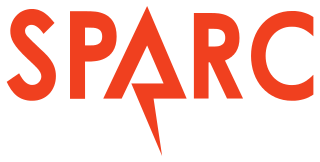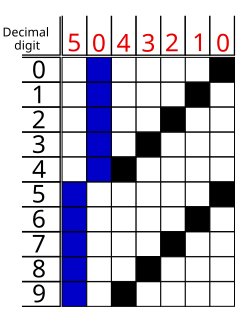Related Research Articles

SPARC is a reduced instruction set computing (RISC) instruction set architecture (ISA) originally developed by Sun Microsystems and Fujitsu. Its design was strongly influenced by the experimental Berkeley RISC system developed in the early 1980s. First developed in 1986 and released in 1987, SPARC was one of the most successful early commercial RISC systems, and its success led to the introduction of similar RISC designs from a number of vendors through the 1980s and 90s.

Fujitsu Limited is a Japanese multinational information technology equipment and services company headquartered in Tokyo, Japan. In 2018, it was the world's fourth-largest IT services provider measured by global IT services revenue. Fortune named Fujitsu as one of the world's most admired companies and a Global 500 company.

Bi-quinary coded decimal is a numeral encoding scheme used in many abacuses and in some early computers, including the Colossus. The term bi-quinary indicates that the code comprises both a two-state (bi) and a five-state (quinary) component. The encoding resembles that used by many abacuses, with four beads indicating either 0 through 4 or 5 through 9 and another bead indicating which of those ranges.
International Computers Limited (ICL) was a large British computer hardware, computer software and computer services company that operated from 1968 until 2002. It was formed through a merger of International Computers and Tabulators (ICT), English Electric Leo Marconi (EELM) and Elliott Automation in 1968. The company's most successful product line was the ICL 2900 Series range of mainframe computers.

FM Towns system is a Japanese variant of PC, built by Fujitsu from February 1989 to the summer of 1997. It started as a proprietary PC variant intended for multimedia applications and PC games, but later became more compatible with IBM PC compatibles. In 1993, the FM Towns Marty was released, a game console compatible with existing FM Towns games.
The VP2000 was the second series of vector supercomputers from Fujitsu. Announced in December 1988, they replaced Fujitsu's earlier FACOM VP Model E Series. The VP2000 was succeeded in 1995 by the VPP300, a massively parallel supercomputer with up to 256 vector processors.
The Fujitsu FACOM VP is a series of vector supercomputers designed, manufactured, and marketed by Fujitsu. Announced in July 1982, the FACOM VP were the first of the three initial Japanese commercial supercomputers, followed by the Hitachi HITAC S-810 in August 1982 and the NEC SX-2 in April 1983.

The PC-9800 series, commonly shortened to PC-98 or 98, is a lineup of Japanese 16-bit and 32-bit personal computers manufactured by NEC from 1982 to 2000. The platform established NEC's dominance in the Japanese personal computer market and by 1999, more than 18 million units were sold.
The history of computer science began long before our modern discipline of computer science, usually appearing in forms like mathematics or physics. Developments in previous centuries alluded to the discipline that we now know as computer science. This progression, from mechanical inventions and mathematical theories towards modern computer concepts and machines, led to the development of a major academic field, massive technological advancement across the Western world, and the basis of a massive worldwide trade and culture.

The transistor count is the number of transistors on an integrated circuit (IC). It typically refers to the number of MOSFETs on an IC chip, as all modern ICs use MOSFETs. It is the most common measure of IC complexity. The rate at which MOS transistor counts have increased generally follows Moore's law, which observed that the transistor count doubles approximately every two years.

Sun Microsystems' UltraSPARC T2 microprocessor is a multithreading, multi-core CPU. It is a member of the SPARC family, and the successor to the UltraSPARC T1. The chip is sometimes referred to by its codename, Niagara 2. Sun started selling servers with the T2 processor in October 2007.

The FM-7 is a home computer created by Fujitsu. It was first released in 1982 and was sold in Japan and Spain. It is a stripped-down version of Fujitsu's earlier FM-8 computer, and during development it was referred to as the "FM-8 Jr.".
A computer is a machine that can be instructed to carry out sequences of arithmetic or logical operations automatically via computer programming. Modern computers have the ability to follow generalized sets of operations, called programs. These programs enable computers to perform an extremely wide range of tasks. A "complete" computer including the hardware, the operating system, and peripheral equipment required and used for "full" operation can be referred to as a computer system. This term may as well be used for a group of computers that are connected and work together, in particular a computer network or computer cluster.

A mechanical computer is built from mechanical components such as levers and gears, rather than electronic components. The most common examples are adding machines and mechanical counters, which use the turning of gears to increment output displays. More complex examples could carry out multiplication and division—Friden used a moving head which paused at each column—and even differential analysis. One model sold in the 1960s calculated square roots.
The SPARC64 V (Zeus) is a SPARC V9 microprocessor designed by Fujitsu. The SPARC64 V was the basis for a series of successive processors designed for servers, and later, supercomputers.
PFU Limited is a Japanese information technology company. The company was formed by the merger of Panafacom and USAC Electronic Industrial in 1987.

The K computer – named for the Japanese word/numeral "kei" (京), meaning 10 quadrillion (1016) – was a supercomputer manufactured by Fujitsu, installed at the Riken Advanced Institute for Computational Science campus in Kobe, Hyōgo Prefecture, Japan. The K computer was based on a distributed memory architecture with over 80,000 compute nodes. It was used for a variety of applications, including climate research, disaster prevention and medical research. The K computer's operating system was based on the Linux kernel, with additional drivers designed to make use of the computer's hardware.
ELOT 927 is 7-bit character set standardized by ELOT, the Hellenic Organization for Standardization (HOS). It is also known as ISO-IR-88, CSISO88GREEK7 or 7-bit DEC Greek. The standard was withdrawn in November 1986. Support for it was implemented in various dot matrix printers and line printers as well as in computer terminals. Support for it can still be found in various applications, languages and protocols today, for example in Perl and Kermit.
The FACOM 100 was an early electromechanical computer built by Fujitsu in 1954. The FACOM 100 used binary-coded decimal arithmetic.
References
- ↑ "FACOM 128A and 128B Relay Computers". museum.ipsj.or.jp. Retrieved 2019-12-01.
- ↑ Hruska, Joel (August 1, 2019). "Fujitsu Has an Employee Who Keeps a 1959 Computer Running". www.extremetech.com. Retrieved 2019-12-01.
- ↑ "Technician keeps computer made in 1959 still humming along". The Asahi Shimbun. Retrieved 2019-12-01.
- ↑ Williams, Al (2019-08-03). "Maybe The Oldest Computer, Probably The Oddest". Hackaday. Retrieved 2019-12-01.